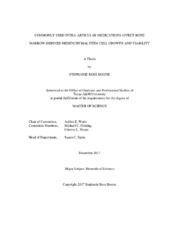| dc.description.abstract | The objective of this work was to describe bone marrow-derived mesenchymal stem cell (MSC) proliferation and characterization after expansion with the common intra-articular medications polysulfated glycosaminoglycan, hyaluronic acid, or hyaluronic acid with chondroitin sulfates C4 and C6 with N-acetyl-D-glucosamine in vitro as an initial screening for combination therapy treatment of degenerative joint conditions in the horse.
MSCs were isolated from bone marrow, then expanded in basal culture media (BCM) or BCM supplemented with a test solution (polysulfated glycosaminoglycan (PSGAG); hyaluronic acid (HA); hyaluronic acid, chondroitin sulfates C4 and C6, and N-acetyl-D-glucosamine (GAGHA)). Viability was assessed with colony forming unit counts (CFU-F), while proliferation assessments included total cell counts, evaluation of growth kinetics with generation tracking intracytoplasmic dye, and culture evaluations of confluency and debris. Characterization by immunophenotyping for surface markers CD29, CD44, CD45, and MHCII, evaluation of differentiation ability into adipocytes, chondrocytes, and osteoblasts, and morphology scoring in culture was performed. Investigation of immunomodulatory activity was assessed by quantification of prostaglandin E₂ (PGE₂) concentration in media supernatants, and senescence was evaluated as a follow-up test in cells expanded with PSGAGs or SF treated media with β-Galactosidase staining (n = 1).
Results of total cell counts, growth kinetics assessment, and culture evaluations for confluency and debris indicated decreased cellular proliferation 72 hours after supplementation with PSGAG, GAGHA, and SF. Viability was decreased in CFU-F cultures supplemented with GAGHA and SF, while colonies failed to form in PSGAG supplemented cultures. Viability was increased in CFU-F cultures supplemented with HA. After 120 hours of expansion with test solutions, there were no significant differences in trilineage differentiation, immunophenotype, or PGE₂ assays. SF cultures stained positively for β-Galactosidase activity and osteogenesis after 10 days of incubation (n = 1).
MSCs expanded with PSGAG, GAGHA, and SF had decreased proliferation and viability in vitro, while proliferation of MSCs cultured with HA was not different from controls. MSC viability and proliferation is inhibited in the presence of PSGAG in vitro. In contrast, viability of MSCs may be improved in the presence of HA, and proliferation is not adversely affected. The results of this study warrant in vivo evaluation. | en |


